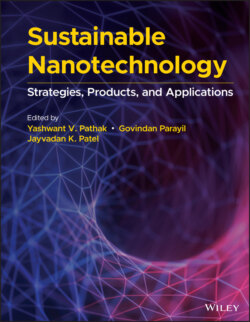Читать книгу Sustainable Nanotechnology - Группа авторов - Страница 26
1.3.2 Application in Food Science
ОглавлениеDue to public apprehension and the regulatory agencies not reaching upon agreement, the application of nanotechnology in food preparation does not have any worldwide applicable rules and, hence, is still in the developmental phase [75–77]. There are various aspects needed to be explored in the relationship between nanotechnology and food preparation. Application, for one, is certainly a matter of discussion [78]. Nanotechnology can have various possible applications in food science. For example, nanomaterials can be used in food products to increase its freshness and improve its taste. This can be done through methods of nanoencapsulation. SiO₂ nanomaterials, for example, can act as carriers for flavors in food [79]. In addition, the functionality of these applications should also be the focus development of this field. What are the reasons for using nanomaterials? Protection against biological deterioration, chemicals, and enhancement of physical properties can be few of the reasons. Furthermore, the safety of using nanomaterials over conventional materials and methods should be assessed, for example, what are the results of these applications in in vivo and in vitro experiments, or do nano‐enhanced food contribute to food allergies? [78]
Healthy and sustainable food is certainly a goal for the future, especially to achieve global sustainability. Sustainability of food is a bit tricky because food has a shelf life and for most items, it is not very long. A reason for that is biological pathogens. Silver nanoparticles and nanocomposites have been identified as antimicrobials by the US FDA. The Ag+ ions in AgNPs are responsible for binding to cause morphological changes and generation of reactive oxygen species by binding to membrane proteins of bacteria. This causes damage to cells and death due to oxidative stress [80, 81]. Even though some nanomaterials are used to cause oxidative stress, there is some that act as antioxidant carriers. A developed example of this is SiO₂‐gallic acid nanoparticles that contain a high capacity of 2,2‐diphenyl‐1‐picrylhydrazyl radicals, a compound used to measure antioxidant activity [82]. Nano‐delivery materials can also be used to increase the BA of bioactive compounds in food products. Depending on the type of bioactive compound, there are many nano‐carries available. For instance, coenzyme Q10 is a lipophilic compound and is not very soluble in water, which is the cause of its low BA. A lipid‐free nano‐CoQ10 system is modified with various surfactants, which improve the solubility and BA of coenzyme Q10 in oral administration [83].
